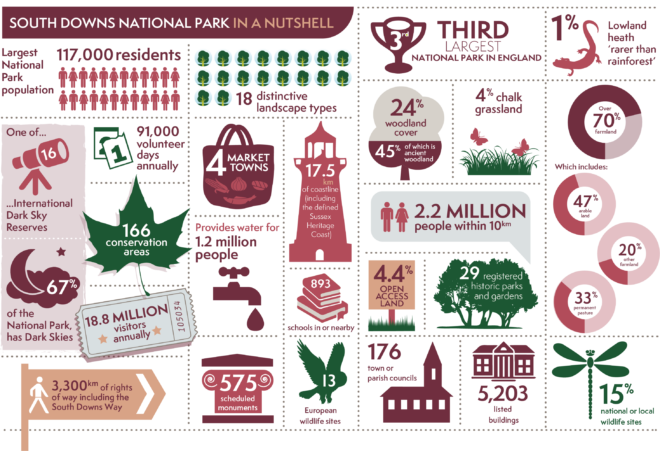Introduction: People, pressure & possibility
The South Downs National Park (National Park) covers over 1,600km2 of England’s most valued lowland landscapes shaped, over millennia, by the people who have lived and worked here.
Its inspirational and varied landscapes, internationally important wildlife, rich cultural heritage, and vibrant market towns and villages hold a special place in the hearts of many millions. During both World Wars the area became symbolic of an England that was worth fighting for. But, situated as it is in the most crowded corner of Britain, it is also under intense pressure.
Most of the South Downs is privately owned and farmed. It is heavily populated compared to other National Parks with 117,000 residents. Its future, like its past, is interdependent with the communities that surround it. More than 2.2 million people – including those in Chichester, Winchester, Worthing, Brighton & Hove, Eastbourne and Alton – live on its doorstep, and London is just over an hour away. Wildlife, the visual landscape, and water know no boundaries.
They bridge the National Park and neighbouring administrative areas, requiring a joined-up approach and strong partnerships to help maintain what is valued.
Millions depend on the National Park’s water, benefit from its wildlife, use its timber and enjoy food and drink produced from its soils. It offers wonderful opportunities for outdoor learning and improves the health of all who simply enjoy fresh air, exercise and the tranquillity which can be found amongst its chalk Downland, farms, heaths, villages, woods and river valleys. These assets or natural capital of the National Park therefore underpin the economy and quality of life in this part of southern England.

But there is no room for complacency. It is remarkable, given the pressures, that the
special qualities of this National Park have remained sufficiently intact to merit its designation alongside other nationally iconic landscapes such as the Cairngorms, Snowdonia or the Lake District. But these qualities cannot be taken for granted, nor, sadly, are they always in the best condition. Challenges include: habitat fragmentation; erosion of landscape quality; loss of built heritage; changes to farming; loss of public services; and lack of affordable housing. Most significant of all, climate change is having fundamental effects on biodiversity, agriculture and water resources. Adapting to it and other pressures will require a post-Brexit deal that supports the rural economy through a major transition.
A special place
Over 1,000 residents, visitors, landowners, farmers, businesses, school pupils and parish councils helped us to define the 7 special qualities of the National Park. These are the ‘stocks’ we have inherited and which we need to nurture and enhance over time.
